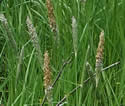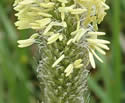Alopecurus pratensis (Meadow Foxtail)
| Also known as: | Field Meadow-Foxtail |
|---|---|
| Genus: | Alopecurus |
| Family: | Poaceae (Grass) |
| Life cycle: | perennial |
| Origin: | Eurasia |
| Status: |
|
| Habitat: | part shade, sun; moist, disturbed soil; roadsides, ditches, fields, shores, stream banks, wetlands |
| Fruiting season: | June - July |
| Plant height: | 1 to 4 feet |
| Wetland Indicator Status: | GP: FACW MW: FACW NCNE: FAC |
| MN county distribution (click map to enlarge): |  |
| National distribution (click map to enlarge): |  |
Pick an image for a larger view. See the glossary for icon descriptions.
Detailed Information
Flower: 


![[photo of flowering spike]](/udata/r9ndp23q/pd3/alopecurus-pratensis-615-2-t.jpg) A single tightly packed, narrowly cylindric, spike-like branching cluster at the top of the stem, 1 to 4 inches long. Spikelets (flower clusters) are 4 to 6 mm (to ~¼ inch) long, flattened, narrowly oblong-elliptic in outline and have a single floret, light to medium green at flowering time. Florets bloom from the top of the spike down, those at the tip of the spike may be forming fruit while those at the base have not yet bloomed.
A single tightly packed, narrowly cylindric, spike-like branching cluster at the top of the stem, 1 to 4 inches long. Spikelets (flower clusters) are 4 to 6 mm (to ~¼ inch) long, flattened, narrowly oblong-elliptic in outline and have a single floret, light to medium green at flowering time. Florets bloom from the top of the spike down, those at the tip of the spike may be forming fruit while those at the base have not yet bloomed.
![[close-up of spike]](/udata/r9ndp23q/pd3/alopecurus-pratensis-062517-1-t.jpg) At the base of a spikelet is a pair of bracts (glumes), both similar, fused together on the lower fourth, 3-veined, long-haired along the keel and lateral veins, sparsely hairy on the surface, 4 to 6 mm long, lance-elliptic with a pointed tip. Florets are surrounded by a pair of bracts (lemma and pales), the lemma about as long as the glumes, 3-veined, hairless, and with a conspicuous awn arising from the lower third of the midvein, the awn 6 to 10 mm long, initially straight becoming bent at maturity, and extending far beyond the tip of the glumes; the palea is obscure or absent.
At the base of a spikelet is a pair of bracts (glumes), both similar, fused together on the lower fourth, 3-veined, long-haired along the keel and lateral veins, sparsely hairy on the surface, 4 to 6 mm long, lance-elliptic with a pointed tip. Florets are surrounded by a pair of bracts (lemma and pales), the lemma about as long as the glumes, 3-veined, hairless, and with a conspicuous awn arising from the lower third of the midvein, the awn 6 to 10 mm long, initially straight becoming bent at maturity, and extending far beyond the tip of the glumes; the palea is obscure or absent.
Leaves and stems: 


![[photo of sheath, ligule and node]](/udata/r9ndp23q/pd3/alopecurus-pratensis-7616-22-t.jpg) Leaves are basal and alternate, erect to ascending, 2 to 16 inches long, 3 to 10 mm (to 3/8 inch) wide, lance-linear, mostly flat. Basal leaves are longest; stem leaves are few and long-sheathing. Sheaths are hairless, the lower tightly wrapping the stem and the upper sometimes slightly inflated and looser, and may be blue-green in color. The ligule (membrane where the leaf joins the sheath) is membranous, 1 to 3 mm long, straight across or convex at the tip, and not fringed with hairs. Nodes are smooth, green to orange. Stems are hairless, erect to ascending, sometimes angled up from the lower node (geniculate), and forming loose clumps from short rhizomes.
Leaves are basal and alternate, erect to ascending, 2 to 16 inches long, 3 to 10 mm (to 3/8 inch) wide, lance-linear, mostly flat. Basal leaves are longest; stem leaves are few and long-sheathing. Sheaths are hairless, the lower tightly wrapping the stem and the upper sometimes slightly inflated and looser, and may be blue-green in color. The ligule (membrane where the leaf joins the sheath) is membranous, 1 to 3 mm long, straight across or convex at the tip, and not fringed with hairs. Nodes are smooth, green to orange. Stems are hairless, erect to ascending, sometimes angled up from the lower node (geniculate), and forming loose clumps from short rhizomes.
Fruit: 
![[photo of mature spikelets]](/udata/r9ndp23q/pd3/alopecurus-pratensis-7716-2-t.jpg) Spikelets turn blackish at maturity, the entire spikelet shedding as each grain matures, leaving the naked stalks behind. Grains (seeds) are 1 to 1.2 mm long.
Spikelets turn blackish at maturity, the entire spikelet shedding as each grain matures, leaving the naked stalks behind. Grains (seeds) are 1 to 1.2 mm long.
Notes:
Meadow Foxtail is a cool-season, Eurasian species introduced as a forage crop, though may have been unintentionally introduced by other means as well. We suspect it is more widespread than the distribution maps indicate. The cylindric spikes resemble those of the more common Timothy (Phleum pratense) which lacks the lemma awns and softly hairy glumes of Meadow Foxtail, and is tan-colored at maturity.
There are 4 Alopecurus species known to be in Minnesota, 2 of which are native. At a glance they may all look similar—narrowly cylindric spikes usually blooming (and completely shedding seed) from the top down, single-flowered spikelets usually blackish when mature, hairy glumes equal in size and shape, and lemma awns arising from the lower half of the lemma—but the size of the spikelet combined with length of the awn can help determine a correct ID. Meadow Foxtail has relatively large spikelets (4 to 6 mm long) and conspicuous awns that extend well beyond the tip of the spikelet. Of the other Alopecurus species in Minnesota, Carolina Foxtail (A. carolinianus) is the only other with such conspicuous awns, but it is a much smaller plant with much smaller spikelets, less than 3.5 mm long. Creeping Foxtail (A. arundinaceus) has spikelets about as large as Meadow Foxtail but its awns barely extend beyond the glumes, if at all.
Native Plant Nurseries, Restoration and Landscaping Services ↓
More photos
 Alopecurus pratensis plants
Alopecurus pratensis plants Alopecurus pratensis plants
Alopecurus pratensis plants Alopecurus pratensis plants
Alopecurus pratensis plants sheaths are sometimes inflated and loose
sheaths are sometimes inflated and loose spike blooming from the top down
spike blooming from the top down maturing spike
maturing spike
Photos by Peter M. Dziuk taken in Cass and Lake counties, and in South Dakota.
Comments
Have you seen this plant in Minnesota, or have any other comments about it?






